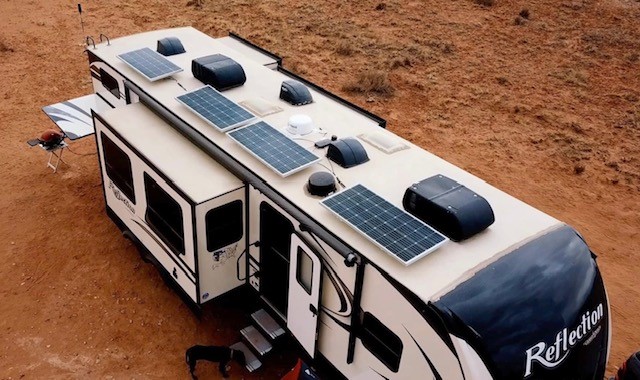RV solar panels are the backbone of your RV solar system. Choosing the right panels for your needs will maximize your solar system’s efficiency, performance, and return on investment. If your looking for RV solar install, RV inverter installations or additional RV batteries please give us a call.
Solar panels consist of multiple individual solar cells that convert sunlight into energy. Several panels can be joined together to create a ‘solar array’ that generates more power. The solar panels generate direct current (DC) electricity used to recharge the RV batteries.
This is always a misconception when talking with RV owners, we end up having to explain that solar panels do not make (AC) electricity known as shore power. Solar panels are only used to charge the batteries, so beside choosing the right solar panel it is equally important to have the right batteries as well.

Grand Design RV Reflection
There are three types of solar panels commonly used in RV applications, each with its own benefits and drawbacks:
Amorphous panels are older solar panels and are often found in first–generation RV installations. While inexpensive, they are fragile, inefficient, and take up the most room. They also degrade quickly when exposed to sunlight and can lose up to 30 percent of their power–generating capabilities in their first year of service. Today, amorphous panels are not widely used in new RV applications.
Polycrystalline panels are more robust than their amorphous
counterparts. They require half the space to produce the same power; however, polycrystalline panels can vary widely in quality and performance.
Monocrystalline panels are considered the most efficient RV
solar panels, with energy efficiency rates typically in the 15–20 percent range. They perform better in high heat and low light environments, making them more versatile for RV operators. While more expensive than polycrystalline options, monocrystalline panels are more durable and typically last longer.

Rigid Versus Flexible Panels
Rigid solar panels, built using a frame surrounding tempered glass covering the solar cells, are the most common option for RVs. Flexible panels, in contrast, have the collecting material embedded into a thin mylar film affixed to an aluminum substrate.
Rigid panels are very durable and typically have longer warranty periods than flexible panels. While flexible versions may be up to 80 percent lighter, they are much more susceptible to damage. Flexible panels are usually reserved for specialty applications; for example, when panels need to be molded to curved surfaces or accommodate height or weight constraints.
Solar Panel Buying Tips
- Cheap solar panels are usually constructed with a lot of cut cells—they may be less expensive, but they’re also less efficient. Full, complete solar cells perform better and are worth the additional cost.
- Look for panels with the highest rated wattage for their size. A smaller footprint means a more efficient panel.
- Watch out for manufacturer claims of wattage output. The best manufacturers will provide a minimum output for their panels, as opposed to a maximum. Always ask your seller to document their panel output range (plus/minus percent).
Our goal is to help you choose the right solar or Inverter system for your RV needs.
We hope you find this information helpful and look forward to helping you with all your RV solar needs.
More from Dustin
Dustin owns and operates California RV Specialists, an independent RV repair shop located in Lodi, CA. He thrives on sharing his knowledge and enthusiasm of RV repair and maintenance with his team, customers, and virtual friends.
Make sure you check out our website, California RV Specialists, and their YouTube channel for more helpful information, and see our published articles on RVtravel.com and other social media pages.
Dustin proudly operates the business alongside his wife, Ashley; but the true pair that run the show are their Boston Terriers, Arvie and Hitch.
